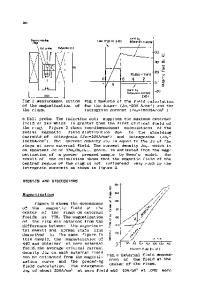Epitaxial Growth and Superconducting Properties of Yba 2 Cu 3 O 7 Thin Films and Yba 2 Cu 3 O 7 /Dy(Pr)Yba 2 Cu 3 O 7 Su
- PDF / 478,764 Bytes
- 8 Pages / 420.48 x 639 pts Page_size
- 66 Downloads / 357 Views
EPITAXIAL GROW/TH PROPERTIES OF YBa9 Cu307 THIN FILMS AND AND YBa SUPERCONDUCTING 2 Cu 3 0 7 /Dy(Pr)Ba 2 Cu 3 07 SUPERLATTICES.j
J.-M. TRI•CONE*, M.G. KARK•T 4.D. KENT , AND 0. FISCHER.
,
0. BRUNNER,9 L. ANTOGNAZZA,
Departement de la Mati~re Condensde, Universit4 de Gen~ve, •~-Ansermet, 1211 Gen~ve, Switzerland. Laboratoire de Chimie Min~rale B, Universit4 de Rennes I, G~ndral-Leclerc, 35042 Rennes cedex, France.
24
Quai
avenue du
ABSTRACT We aveprpardi stu E~2Cu307 (REBC0) (RE= Y, Pr, Dy) thin films YBCO/Dy(Pr)BCO superlattices by single target dc planar magnetron sputtering. YBCO/DyBC0 superlattices have been realized with modulation wavelength as short as 24A, i.e., a unit cell of YBCO alternates with a unit cell of DyBCO, on average. The superconducting properties of such superlattices are indistinguishable from those of single layers. T 's (zero resistance) are between 85 and 89K, and the residual resistivity ralos are between 2.5 and 3. In contrast to these results, when YBCO is layered with PrBCO, which is insulating, a dramatic change in the superconducting properties is observed. We have been able to artificially vary the coupling between single 12A unit cell of YBCO by interposing insulating planes of PrBCO. As the YBCO layer separation increases, T is reduced and the transition broadens showing • evidence of 2-D superconducting fluctuations.
and
~c.
INTRODUCTION.
The high-T superconductors (HTS) have a naturally layered structure and c their transport properties are highly anisotropic. Superconductivity is related to the presence of CuO planes sandwiched in various stacks of layers. In YBCO the distance between adjacent CuO bi-layers is about 12A[1]. In the Bi or T1 series, the distance between the groups of CuO planes is even larger[l] and these materials are found to be much more anisotropic than YBCO and show a behavior possibly related to two dimensional fluctuations[2]. A challenge clearly exists to modify the structural properties of these materials in a systematic way and to study the influence on the superconducting properties. In spite of the difficulties often encountered with thin film deposition of HTS, we have found that these materials can be produced layer by layer[3]. It is therefore possible to use a multilayer approach to artificially modify the superconducting properties of these materials. In this paper we report crystallographic characterization, using of fangle x-rays, of single YBCO thin films, and our progress towards the artificial construction of HTS: the growth of YBCO/DyBC0 superlattices and recent results on YBCO/PrBCO superlattices where we have used the insulating character of PrBCO to study the behavior of single 12A YBCO layers.
DEPOSITION TECHNIQUE.
Our single thin films and superlattices are prepared by dc planar magnetron sputtering using one (two for the multilayers) single stoichiometric target of REBCOI4]. The substrates-target distance is 2-3cm with our substrates directly facing the target. We have used the idea of Li et al.[5] to sputter at high eno
Data Loading...











